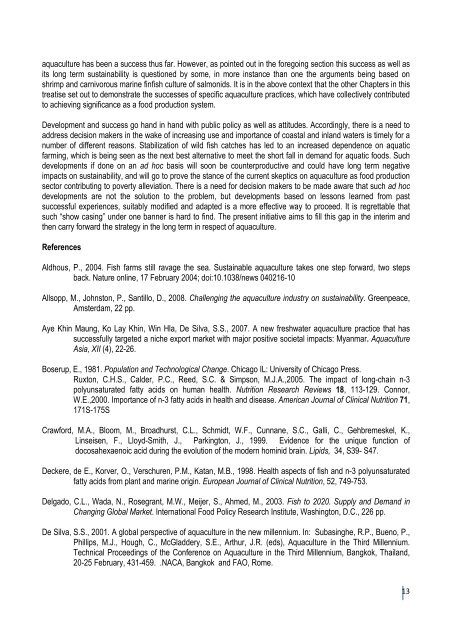Training of Trainers - Library - Network of Aquaculture Centres in ...
Training of Trainers - Library - Network of Aquaculture Centres in ...
Training of Trainers - Library - Network of Aquaculture Centres in ...
- No tags were found...
You also want an ePaper? Increase the reach of your titles
YUMPU automatically turns print PDFs into web optimized ePapers that Google loves.
aquaculture has been a success thus far. However, as po<strong>in</strong>ted out <strong>in</strong> the forego<strong>in</strong>g section this success as well asits long term susta<strong>in</strong>ability is questioned by some, <strong>in</strong> more <strong>in</strong>stance than one the arguments be<strong>in</strong>g based onshrimp and carnivorous mar<strong>in</strong>e f<strong>in</strong>fish culture <strong>of</strong> salmonids. It is <strong>in</strong> the above context that the other Chapters <strong>in</strong> thistreatise set out to demonstrate the successes <strong>of</strong> specific aquaculture practices, which have collectively contributedto achiev<strong>in</strong>g significance as a food production system.Development and success go hand <strong>in</strong> hand with public policy as well as attitudes. Accord<strong>in</strong>gly, there is a need toaddress decision makers <strong>in</strong> the wake <strong>of</strong> <strong>in</strong>creas<strong>in</strong>g use and importance <strong>of</strong> coastal and <strong>in</strong>land waters is timely for anumber <strong>of</strong> different reasons. Stabilization <strong>of</strong> wild fish catches has led to an <strong>in</strong>creased dependence on aquaticfarm<strong>in</strong>g, which is be<strong>in</strong>g seen as the next best alternative to meet the short fall <strong>in</strong> demand for aquatic foods. Suchdevelopments if done on an ad hoc basis will soon be counterproductive and could have long term negativeimpacts on susta<strong>in</strong>ability, and will go to prove the stance <strong>of</strong> the current skeptics on aquaculture as food productionsector contribut<strong>in</strong>g to poverty alleviation. There is a need for decision makers to be made aware that such ad hocdevelopments are not the solution to the problem, but developments based on lessons learned from pastsuccessful experiences, suitably modified and adapted is a more effective way to proceed. It is regrettable thatsuch “show cas<strong>in</strong>g” under one banner is hard to f<strong>in</strong>d. The present <strong>in</strong>itiative aims to fill this gap <strong>in</strong> the <strong>in</strong>terim andthen carry forward the strategy <strong>in</strong> the long term <strong>in</strong> respect <strong>of</strong> aquaculture.ReferencesAldhous, P., 2004. Fish farms still ravage the sea. Susta<strong>in</strong>able aquaculture takes one step forward, two stepsback. Nature onl<strong>in</strong>e, 17 February 2004; doi:10.1038/news 040216-10Allsopp, M., Johnston, P., Santillo, D., 2008. Challeng<strong>in</strong>g the aquaculture <strong>in</strong>dustry on susta<strong>in</strong>ability. Greenpeace,Amsterdam, 22 pp.Aye Kh<strong>in</strong> Maung, Ko Lay Kh<strong>in</strong>, W<strong>in</strong> Hla, De Silva, S.S., 2007. A new freshwater aquaculture practice that hassuccessfully targeted a niche export market with major positive societal impacts: Myanmar. <strong>Aquaculture</strong>Asia, XII (4), 22-26.Boserup, E., 1981. Population and Technological Change. Chicago IL: University <strong>of</strong> Chicago Press.Ruxton, C.H.S., Calder, P.C., Reed, S.C. & Simpson, M.J.A.,2005. The impact <strong>of</strong> long-cha<strong>in</strong> n-3polyunsaturated fatty acids on human health. Nutrition Research Reviews 18, 113-129. Connor,W.E.,2000. Importance <strong>of</strong> n-3 fatty acids <strong>in</strong> health and disease. American Journal <strong>of</strong> Cl<strong>in</strong>ical Nutrition 71,171S-175SCrawford, M.A., Bloom, M., Broadhurst, C.L., Schmidt, W.F., Cunnane, S.C., Galli, C., Gehbremeskel, K.,L<strong>in</strong>seisen, F., Lloyd-Smith, J., Park<strong>in</strong>gton, J., 1999. Evidence for the unique function <strong>of</strong>docosahexaenoic acid dur<strong>in</strong>g the evolution <strong>of</strong> the modern hom<strong>in</strong>id bra<strong>in</strong>. Lipids, 34, S39- S47.Deckere, de E., Korver, O., Verschuren, P.M., Katan, M.B., 1998. Health aspects <strong>of</strong> fish and n-3 polyunsaturatedfatty acids from plant and mar<strong>in</strong>e orig<strong>in</strong>. European Journal <strong>of</strong> Cl<strong>in</strong>ical Nutrition, 52, 749-753.Delgado, C.L., Wada, N., Rosegrant, M.W., Meijer, S., Ahmed, M., 2003. Fish to 2020. Supply and Demand <strong>in</strong>Chang<strong>in</strong>g Global Market. International Food Policy Research Institute, Wash<strong>in</strong>gton, D.C., 226 pp.De Silva, S.S., 2001. A global perspective <strong>of</strong> aquaculture <strong>in</strong> the new millennium. In: Subas<strong>in</strong>ghe, R.P., Bueno, P.,Phillips, M.J., Hough, C., McGladdery, S.E., Arthur, J.R. (eds), <strong>Aquaculture</strong> <strong>in</strong> the Third Millennium.Technical Proceed<strong>in</strong>gs <strong>of</strong> the Conference on <strong>Aquaculture</strong> <strong>in</strong> the Third Millennium, Bangkok, Thailand,20-25 February, 431-459. .NACA, Bangkok and FAO, Rome.13
















